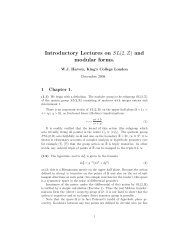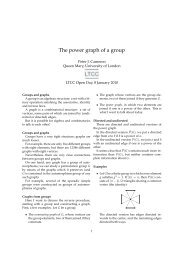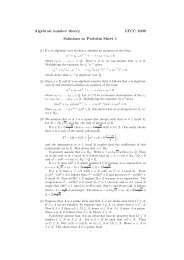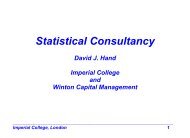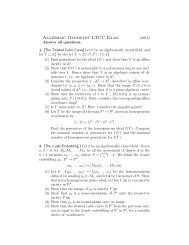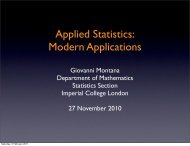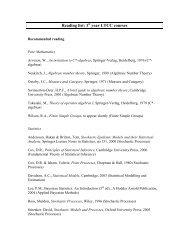Quadratic Forms and Closed Geodesics
Quadratic Forms and Closed Geodesics
Quadratic Forms and Closed Geodesics
Create successful ePaper yourself
Turn your PDF publications into a flip-book with our unique Google optimized e-Paper software.
Class Numbers<br />
h(d) = number of inequivalent forms of discriminant d.<br />
h(d) d=<br />
1 5, 8, 12, 13, 17, 21, 24, 28, 29, 33, 37, 41, 44, 53<br />
2 40, 60, 65, 85, 104, 105, 120, 136, 140, 156, 165<br />
3 229, 257, 316, 321, 469, 473, 568, 733, 761, 892<br />
4 145, 328, 445, 505, 520, 680, 689, 777, 780, 793<br />
5 401, 817, 1093, 1393, 1429, 1641, 1756, 1897, ...<br />
◮ D = {d|d > 0, d ≡ 0, 1 (mod 4), d ≠ □}<br />
◮ x 2 − dy 2 = 4, fundamental solution (t, u)<br />
ɛ d = t + u√ d<br />
2<br />
◮ Gauss, Siegel (1944)<br />
∑<br />
h(d) log ɛ d = π2 x 3/2<br />
+ O(x log x).<br />
18ζ(3)<br />
d∈D,d≤x<br />
ζ(s) =<br />
∞∑<br />
n=1<br />
1<br />
, R(s) > 1.<br />
ns <strong>Quadratic</strong> <strong>Forms</strong><br />
<strong>and</strong> <strong>Closed</strong><br />
<strong>Geodesics</strong><br />
Y. Petridis<br />
<strong>Quadratic</strong> <strong>Forms</strong><br />
Hyperbolic<br />
surfaces<br />
<strong>Closed</strong><br />
<strong>Geodesics</strong><br />
Spectral Theory



